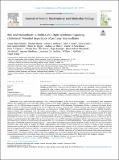Files in this item
Bile acid biosynthesis in Smith-Lemli-Opitz syndrome bypassing cholesterol : Potential importance of pathway intermediates
Item metadata
| dc.contributor.author | Abdel-Khalik, Jonas | |
| dc.contributor.author | Hearn, Thomas | |
| dc.contributor.author | Dickson, Alison L | |
| dc.contributor.author | Crick, Peter J | |
| dc.contributor.author | Yutuc, Eylan | |
| dc.contributor.author | Austin-Muttitt, Karl | |
| dc.contributor.author | Bigger, Brian W | |
| dc.contributor.author | Morris, Andrew A | |
| dc.contributor.author | Shackleton, Cedric H | |
| dc.contributor.author | Clayton, Peter T | |
| dc.contributor.author | Iida, Takashi | |
| dc.contributor.author | Sircar, Ria | |
| dc.contributor.author | Rohatgi, Rajat | |
| dc.contributor.author | Marschall, Hanns-Ulrich | |
| dc.contributor.author | Sjövall, Jan | |
| dc.contributor.author | Björkhem, Ingemar | |
| dc.contributor.author | Mullins, Jonathan G L | |
| dc.contributor.author | Griffiths, William J | |
| dc.contributor.author | Wang, Yuqin | |
| dc.date.accessioned | 2022-10-26T15:30:19Z | |
| dc.date.available | 2022-10-26T15:30:19Z | |
| dc.date.issued | 2021-02 | |
| dc.identifier | 281861046 | |
| dc.identifier | cb1a78e2-b25e-4cf1-be2c-58fed783a18e | |
| dc.identifier | 33246156 | |
| dc.identifier | 85097453475 | |
| dc.identifier.citation | Abdel-Khalik , J , Hearn , T , Dickson , A L , Crick , P J , Yutuc , E , Austin-Muttitt , K , Bigger , B W , Morris , A A , Shackleton , C H , Clayton , P T , Iida , T , Sircar , R , Rohatgi , R , Marschall , H-U , Sjövall , J , Björkhem , I , Mullins , J G L , Griffiths , W J & Wang , Y 2021 , ' Bile acid biosynthesis in Smith-Lemli-Opitz syndrome bypassing cholesterol : Potential importance of pathway intermediates ' , The Journal of Steroid Biochemistry and Molecular Biology , vol. 206 , 105794 . https://doi.org/10.1016/j.jsbmb.2020.105794 | en |
| dc.identifier.issn | 0960-0760 | |
| dc.identifier.other | PubMedCentral: PMC7816163 | |
| dc.identifier.other | ORCID: /0000-0002-4150-2467/work/121753965 | |
| dc.identifier.uri | https://hdl.handle.net/10023/26255 | |
| dc.description | This work was supported by the UKRI Biotechnology and Biological Sciences Research Council (BBSRC, grant numbers BB/I001735/1 and BB/N015932/1 to WJG, BB/L001942/1 to YW); the European Union through European Structural Funds (ESF), as part of the Welsh Government funded Academic Expertise for Business project (to WJG and YW); the Swedish Science Council (to IB); and in the US by NIH/NIGMS (GM106078 to RR); and NIH (5R01HD053036to CHS). ALD was supported via a KESS2 award in association with Markes International from the Welsh Government and the European Social Fund. JAK was supported by a PhD studentship from Imperial College Healthcare Charities. KA-M was supported by a PhD studentship from Moleculomics Ltd. | en |
| dc.description.abstract | Bile acids are the end products of cholesterol metabolism secreted into bile. They are essential for the absorption of lipids and lipid soluble compounds from the intestine. Here we have identified a series of unusual Δ5-unsaturated bile acids in plasma and urine of patients with Smith-Lemli-Opitz syndrome (SLOS), a defect in cholesterol biosynthesis resulting in elevated levels of 7-dehydrocholesterol (7-DHC), an immediate precursor of cholesterol. Using liquid chromatography - mass spectrometry (LC-MS) we have uncovered a pathway of bile acid biosynthesis in SLOS avoiding cholesterol starting with 7-DHC and proceeding through 7-oxo and 7β-hydroxy intermediates. This pathway also occurs to a minor extent in healthy humans, but elevated levels of pathway intermediates could be responsible for some of the features SLOS. The pathway is also active in SLOS affected pregnancies as revealed by analysis of amniotic fluid. Importantly, intermediates in the pathway, 25-hydroxy-7-oxocholesterol, (25R)26-hydroxy-7-oxocholesterol, 3β-hydroxy-7-oxocholest-5-en-(25R)26-oic acid and the analogous 7β-hydroxysterols are modulators of the activity of Smoothened (Smo), an oncoprotein that mediates Hedgehog (Hh) signalling across membranes during embryogenesis and in the regeneration of postembryonic tissue. Computational docking of the 7-oxo and 7β-hydroxy compounds to the extracellular cysteine rich domain of Smo reveals that they bind in the same groove as both 20S-hydroxycholesterol and cholesterol, known activators of the Hh pathway. | |
| dc.format.extent | 15 | |
| dc.format.extent | 8043620 | |
| dc.language.iso | eng | |
| dc.relation.ispartof | The Journal of Steroid Biochemistry and Molecular Biology | en |
| dc.subject | Bile acids and salts/biosynthesis | en |
| dc.subject | Cholesterol/biosynthesis | en |
| dc.subject | Chromatography, liquid | en |
| dc.subject | Dehydrocholesterols/chemistry | en |
| dc.subject | Humans | en |
| dc.subject | Lipogenesis/genetics | en |
| dc.subject | Mass spectrometry | en |
| dc.subject | Molecular docking simulation | en |
| dc.subject | Smith-Lemli-Opitz Syndrome/genetics | en |
| dc.subject | QD Chemistry | en |
| dc.subject | QH301 Biology | en |
| dc.subject | DAS | en |
| dc.subject.lcc | QD | en |
| dc.subject.lcc | QH301 | en |
| dc.title | Bile acid biosynthesis in Smith-Lemli-Opitz syndrome bypassing cholesterol : Potential importance of pathway intermediates | en |
| dc.type | Journal article | en |
| dc.contributor.institution | University of St Andrews. School of Medicine | en |
| dc.identifier.doi | https://doi.org/10.1016/j.jsbmb.2020.105794 | |
| dc.description.status | Peer reviewed | en |
This item appears in the following Collection(s)
Items in the St Andrews Research Repository are protected by copyright, with all rights reserved, unless otherwise indicated.

